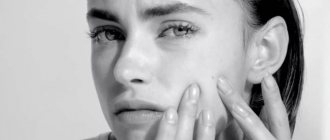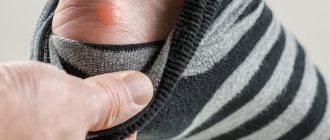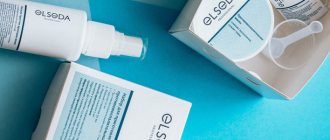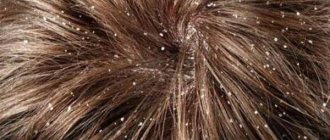Why do elbows get dark?
As you know, the skin contains subcutaneous fatty tissue, dermis (the skin itself) and epidermis. The epidermis has five layers. Of these, the uppermost one, the horny one, is characterized by high resistance to external irritants. A healthy stratum corneum serves as a barrier to pathogens of infectious diseases; its scales are regularly replaced by new cells.
However, when certain diseases occur, such as hyperkeratosis (increased thickening of the stratum corneum of the epidermis), the rejection of old scales slows down, as a result of which the skin of the elbows thickens, becomes rough, and is prone to the appearance of black spots.
When dark spots appear on the skin of the elbow joints, you need to think about some metabolic disorders and digestion. The reason for this may be lack of hygienic body care, deficiency of thyroid hormones, and insufficient intake of vitamins A and E.
To improve the situation and maintain the normal condition of the skin, between seasons it is recommended to take useful complexes containing vitamins A and E. The following foods should always be included in the daily diet:
- Dairy products, orange and red fruits, vegetables, fresh herbs, beef liver, which are rich in vital vitamin A.
- Vegetable oil: almond, olive, sesame, containing large amounts of vitamin E. Moreover, sesame oil, thanks to its healing properties, restores damaged skin and hair, and improves complexion. It is prescribed for the treatment and prevention of diseases of the gastrointestinal tract.
Provoking factors ⠀
There are a number of factors that stimulate keratinization of the elbows and knees against the background of the underlying disease, provoking the development of this symptom:
- Lack of vitamins A, D, E and C;
- Seasonal factors - temperature changes, wearing rough clothes that irritate the skin;
- Taking long baths , especially with chlorinated water in combination with foam (dehydrates the skin, disrupting its barrier functions);
- The main factor is mechanical - the habit of leaning on your elbow when sitting at a table while working, eating, reading, etc.
How to whiten elbows at home
Potatoes, starch
To soften the skin on the elbows in the evening before bed, it is recommended to take baths of potato broth for 10 minutes, then apply a nourishing cream. If you have rough skin, a compress made from a mixture of milk and mashed potatoes will help you eliminate dark elbows.
To do this, spread the composition on a napkin and secure it with a bandage to the area of the black elbow spot. Warm baths made of corn or potato starch effectively help remove blackness and keratinization of the elbows, and increase the strength and elasticity of the skin. A condensed decoction of oatmeal is also suitable. After the procedure, you should rub in cosmetic milk or nourishing cream.
Lemon
Compositions containing lemon juice are very effective in getting rid of black or dark elbows. However, these methods are contraindicated for dry sensitive skin:
- To deeply cleanse and brighten the skin, apply masks based on milk, oatmeal and lemon juice.
- To whiten dark elbows, wipe them with a cloth moistened with a mixture of two tablespoons of rose water and one teaspoon of lemon juice.
A crumb of bread dipped in warm milk will help you get rid of dark elbows with dry skin. Other folk ways to get rid of black spots on the elbows and make your skin lighter and softer:
- Pour boiling water over the oatmeal, apply a warm mask, cover with cellophane film, wash off the mixture with warm water after twenty minutes, then apply a nourishing cream.
- The rough, dry skin of the elbows is lubricated with fresh cucumber juice.
- To restore elasticity and eliminate cracks, you should wash the black stains with coffee grounds.
- Dark, rough skin on the elbows can be softened by applying a medicinal mixture consisting of one chicken egg yolk and two tablespoons of pharmaceutical glycerin.
How to prevent diabetes?
According to modern concepts, insulin resistance long precedes the disease and is considered as an important link in the development of prediabetes and type 2 diabetes. With insulin resistance, muscle, fat and liver cells do not respond properly to insulin and cannot easily absorb glucose from the blood. The body needs more insulin, so the pancreas begins to work harder. Insulin
is a hormone of the pancreas. Its main function is to help tissues absorb glucose. Food carbohydrates - sugars and starches, entering the intestines, are broken down into glucose. Glucose is a form of sugar that is present in the bloodstream. Thanks to insulin, the body's cells absorb glucose and use it for energy.
After eating, glucose levels rise, so the pancreas actively synthesizes insulin, which reduces its concentration. Insulin has several effects, so a healthy person's blood glucose and insulin levels are within the normal range.
The leading factors in the development of insulin resistance are:
Fat tissue produces hormones and other substances that can cause serious health problems: insulin resistance, high blood pressure, cholesterol imbalance and, as a result, cardiovascular disease.
|
Muscles are the main consumer of glucose. After training, they become more sensitive to insulin. Blood glucose levels decrease. This way, exercise helps your muscles absorb glucose better.
Other causes of insulin resistance:
|
Insulin resistance usually does not cause any noticeable symptoms.
The main laboratory sign of insulin resistance is increased blood glucose and insulin levels. The simplest method for assessing insulin resistance is the index of insulin resistance (HOMA-IR). It is a marker of mortality risk. It makes sense to perform the test if your fasting glucose level is less than 7 mmol/l. Must be performed once every 3 years, starting at age 20. If the body mass index (BMI) is more than 25 kg/m2, then at least once a year, starting at any age.
How insulin resistance turns into prediabetes and diabetes
Insulin resistance itself does not cause type 2 diabetes. Tissue insensitivity to insulin only increases the risk of developing prediabetes and type 2 diabetes. Prediabetes usually occurs in people who already have insulin resistance.
| In prediabetes, pancreatic cells can no longer produce enough insulin to overcome insulin resistance. As a result, blood glucose levels rise above the normal range. However, this is not diabetes yet, and if habits are changed in a timely manner, the process can be reversed. Prediabetes occurs if you have:
|
Prediabetes usually has no symptoms.
However, people with severe insulin resistance and prediabetes may have dark patches of skin, usually on the back of the neck. Dark spots may appear on the elbows, knees, knuckles and armpits. This condition is called acanthosis nigricans. Laboratory testing for prediabetes
The values of indicators are given in accordance with the recommendations of the American Diabetes Association (Standards of medical care in diabetes - 2016).
Prediabetes may be detected by one of the following tests:
- Glycated hemoglobin test (HbAC1) Characterizes the average blood glucose level over the past 3 months. This test is the most reliable test for prediabetes, but it is not as sensitive as other tests. The HbAC1 test may not be helpful in people with certain conditions. For example, in people of African, Mediterranean or Asian descent, or people with sickle cell disease or thalassemia. Atypical hemoglobin may be present in the blood of such people. An HbAC1 of 5.7 to 6.4 percent indicates prediabetes.
- Fasting plasma glucose test. This test measures blood glucose levels in people who have not eaten for at least 12 hours. The morning measurement is the most accurate. A fasting glucose level of 100 to 125 mg/hl indicates prediabetes.
- Glucose tolerance test. This test measures blood glucose levels after 12 hours of fasting and 2 hours after drinking a glucose solution. Glucose levels are measured twice during the test. Blood glucose levels between 140 and 199 mg/hl indicate prediabetes.
Not all people diagnosed with prediabetes will develop diabetes.
Research has shown that most people progress from prediabetes to type 2 diabetes within 10 years unless lifestyle changes are made. When prediabetes is diagnosed, continued loss of beta cell function usually leads to type 2 diabetes. People with the disease have high blood glucose levels. Over time, high concentrations of glucose in the blood damage nerves and blood vessels, leading to complications such as heart disease, stroke, blindness, kidney failure and, in advanced cases, lower limb amputations.
How to get rid of black spots on elbows
Bath, soap
Dilute one teaspoon of liquid soap in a liter of warm water, add two teaspoons of baking soda. Mix all ingredients thoroughly:
- Apply nourishing cream to dark spots.
- Defective elbow joints are kept in the bath for 10 minutes, while the keratinized areas are gently rubbed with pumice.
- Apply nourishing cream again.
- Place the joints in the bath for another 10 minutes.
- Wipe the skin dry and apply a softening cosmetic cream.
Oil bath
To soften keratinized areas, dark elbow spots are placed for 20 minutes in a bath filled with warm vegetable or olive oil.
Bath procedures
While visiting the bathhouse, you need to steam thoroughly, wash the dark spots thoroughly with a washcloth, rub them with a pumice stone for at least one minute, while making light round movements.
ethnoscience
Traditional treatment for black elbows is quite popular among adherents of alternative medicine. Let's look at a couple of recipes.
Burdock oil
To begin, thoroughly steam the problem area. After the bath, cleanse your skin with a scrub to remove the dead skin layer. When your elbows are clean, pour burdock oil into your palm and rub it into the steamed area with light massage movements.
Traditional treatment of black elbows with burdock
Big burdock, also known as burdock
Used in folk medicine to treat various skin diseases: acne, rashes, pimples. An aqueous infusion of a medicinal plant, when used externally, significantly softens rough, rough skin on the heels, elbows, and knees. It is recommended to frequently wash the indicated areas with infusion or burdock tincture diluted with water.
Burr oil
You can purchase it at the pharmacy chain. Eliminates dark spots on the elbows, has a softening and whitening effect on rough skin. Before performing the treatment procedure, you should prepare a scrub consisting of a mixture of 1 teaspoon of table salt and 1 teaspoon of sour cream.
- Heat a small amount of burdock oil in a small container filled with hot water or in a water bath. Pour into sockets of suitable volume.
- Problem areas of the skin are placed in oil for 15 minutes.
- Wash off the oil using a soft washcloth and liquid soap.
- Rub the scrub in with gentle movements for two to three minutes, then wash off the composition with warm water.
- Wipe the skin dry and apply a cosmetic nourishing cream.
Why are elbows dark and rough and what to do?
The presence of dark, rough elbows on the hands does not always mean that a person is sloppy.
In most cases, a change in the color and surface of the skin tissue at the bend occurs due to internal pathologies and contact of the elbows with hard surfaces.
Let's look at all the causes of dark elbows and how to treat them. WHY DO ELBOWS BECOME DARK AND ROUGH?
The main cause of dry, rough, and darkened skin on the elbows is friction or pressure.
Typically, the load on the elbows occurs when a person leans on them while sitting at a table. The habit of reading while lying on the floor with your elbows on the carpet and working at the computer in an awkward position, in which your dominant hand slides along the table, lead to deterioration of the skin of the elbows. The area of the limb can become not only unsightly, but also painful.
Why else can elbows be dark and rough? For some people, the problem arises from wearing woolen or synthetic clothing with tight sleeves, which rub against the elbows as they move and spoil their appearance. The causes of unsightly elbows also include improper body care and a deficiency of vitamins A and E in the body. The lack of these substances leads to darkening and dryness of the tissues.
If you understand that the deterioration in the appearance of your elbows is not associated with friction, pressure and wearing clothes, consult a doctor to identify the true causes of the problem. Roughness and blackening of the elbow surfaces may signal the development of pathology.
Now let's list the diseases that cause the elbows to turn black. Dry skin and darkening are associated with several health conditions:
Iron-deficiency anemia;
dermatological problems;
autoimmune diseases;
diabetes mellitus – due to impaired nutrition of the body’s cells, the skin becomes thinner and drier, prone to inflammation and infection;
Hypothyroidism is a disease of the thyroid gland, in which metabolic processes and the rate of cell recovery are reduced. Dead particles from the skin are not exfoliated, so the elbows become dark and rough.
Thus, the main causes of dark elbows are endocrine disorders. To establish them, the patient is asked to undergo a comprehensive examination, according to the results of which a specialist will be able to assess blood sugar levels and the condition of the thyroid gland.
The doctor must also confirm or deny the facts of the development of allergies, anemia and skin diseases. Next, he will tell you how to treat black elbows.
WAYS TO IMPROVE THE LOOK OF DARK ELBOWS: BATHS AND SCRUBS
Procedures to improve the condition of elbows include soda and salt baths.
The elbows are steamed in the solution for 20 minutes, and it is prepared from 1 liter of water, 50 g of soda and 100 g of salt. When the rough skin softens, it is carefully cleaned with pumice, the area is dried with a towel and treated with a nourishing cream. Salt and soda remove keratinized particles, and hot baths speed up the process of blood flow to the elbows.
The composition for baths can also be easily prepared from ammonia diluted in water. Concentration – 1 tsp. drug per 1 liter of liquid. For greater effectiveness, the solution can be supplemented with liquid soap. It is administered in the amount of 1 tsp.
Baths of fermented milk drinks are another answer to the question of how to whiten black elbows. Yogurt or kefir is heated to an acceptable temperature and the elbows are immersed in it. After 15 minutes, problem areas are treated with oil containing liquid vitamins A or E. Shea butter does a very good job of softening and brightening elbows. It is diluted with vitamins independently.
To prepare a scrub that removes roughness from elbows, you need:
milk – 10 ml;
liquid honey – 2 ml;
Shea butter – 10 g;
ground coffee – 2 g;
coarse sea salt – 2 g;
natural soap shavings – 50 g.
The grated soap is combined with Shea butter (karite) and heated in a water bath over low heat. The mixture is diluted with milk and honey and stirred until smooth. When it cools down, ground coffee is added to it. The bottom of a convenient mold is sprinkled with sea salt and the soap mass is laid out. To harden the scrub in the form of soap, it is placed in the refrigerator.











